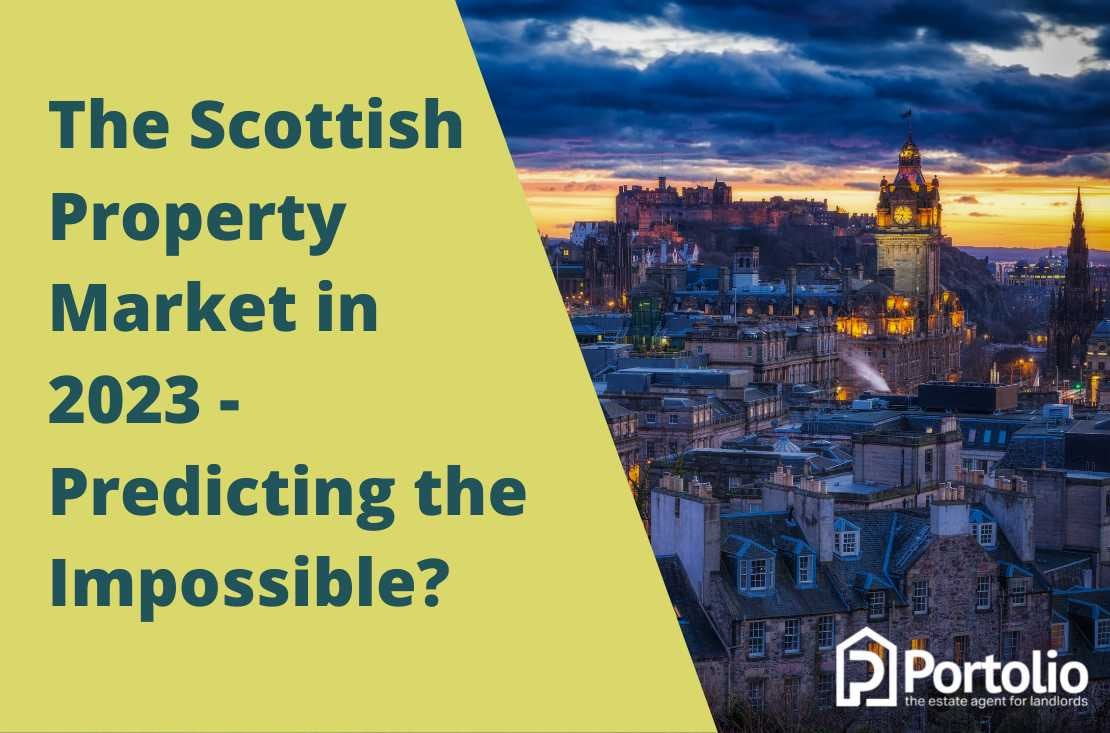After the rollercoaster that was 2022, who would dare to predict what 2023 might bring?!
As a relaxing pastime, projecting what is going to happen with the Scottish property market in 2023 is right up there with juggling venomous snakes or arm wrestling an angry gorilla. You think you know what’s going to happen, but you’re not certain!
As we do every year, we have spoken to a number of leading figures in the Scottish property investment market and asked the simple question: “What do you think will happen in the market in 2023?”.
Their answers are interesting and enlightening, and despite all the downbeat press coverage we saw in 2022, far from overwhelmingly negative.
There is still a very high demand for rented properties, so can the buy-to-let market still deliver the returns to attract new landlords and retain those already active?
As experienced property pros, we’ll let some other professionals share their thoughts!
“What do you think will happen in the market in 2023?”
That’s the question we posed to some of the top property contributors. Here’s what they had to say:

We’re moving into what’s going to be a tricky time. The Bank of England has upped rates in order to control inflation, which is largely affected by energy prices.
House prices however, have also steadily increased since Covid, and we’re now moving into a period where buying is going to be harder.
High prices, coupled with higher interest payments, makes larger purchases unattainable for some buyers higher up the market. At the lower end we still have huge over demand for property, which means the segment stays buoyant.
We may not see prices well over Home Report value being paid as in the last year, but people still need to live somewhere, and therefore investing in Edinburgh remains popular.
The rental market is incredibly busy, as some landlords have exited the market due to the increased red tape over the last couple of years.
The short-term let licence (now delayed until late 2023) is going to make an impact later next year, as those operators who were refused may well turn to the long term let market, or even decide to sell.
Investing in Edinburgh is always a good plan, and we may well see some good deals coming through later next year due to the ongoing circumstances in the city centre.


As we reflect on 2022, it is actually hard to fathom everything that has happened this year.
In spite of the challenging economic landscape the property market has remained surprisingly resilient throughout 2022, especially within the context of the sharp increase in interest rates.
Hansar’s view is that the high rise in property prices will slow somewhat over the course of 2023, however the continued lack of quality housing in desirable areas will mean that demand is higher than supply.
We feel that the Bank of England will taper off the base rate increases towards the end of Q1 in 2023.
Pending the prevailing rate of inflation stabilising at the time, we wouldn’t be surprised if we see a reversal in interest rates moving into summer 2023 and the second half of the year.
There are no UK interest rate forecasts beyond 2025, as there are many complex factors at play that can affect indicators for interest-rate decisions, such as inflation, economic growth rate and unemployment.
We are fairly certain however that the years of sub-2% base rates are unlikely to be seen again any time soon.
Due to the constantly changing economic climate in 2022 there has never been a time where getting expert mortgage advice was more important to ensure you get the best value for your money in your home buying or property investment journey.

Despite all the doom and gloom in the media I am optimistic about the property market in 2023, and I predict rental demand to stay strong with a shortage of stock to continue due to smaller landlords exiting the market.
I don’t think we will see the same increase in rents we did this year as the majority of wages won’t be increasing in line with inflation, but I’m expecting many landlords that didn’t increase rents to do so once the rent freeze ends in March.
Interest rates have been a hot topic over the last 6 months, I can see the base rate continuing to rise to around 4.5% to try to combat inflation.

Fixed rates have already priced this in so expecting mortgage lenders to become more competitive and relax criteria as they see a drop in applications.
Low yielding high value properties are becoming less appealing due to current rates, and I can see high yielding properties becoming more popular.
The market has already cooled down considerably and many are not wanting to commit to a purchase when there is so much talk of a ‘crash’.
I think prices will soften next year and we will see properties selling near Home Report, with less popular properties selling below asking price. Once buyers and sellers adjust to the new market conditions, expect transactions to increase again.
As an investor I remain excited about the property market in 2023 and think there will be opportunities to obtain properties that were previously difficult to buy at a reasonable price while the market was so buoyant over the last couple of years.

Despite the demand for rental properties being at an all-time high, landlords are struggling to cope with the increasing burden of new legislation and the cost of living rises which are affecting us all.
No doubt 2023 will be a year for landlords to take stock and evaluate their portfolios, consolidating where possible to ensure their lettings business is sustainable for the future.
As always, SAL will be on hand to support landlords and letting agents through these turbulent times.

Rents throughout 2022 have been continually on the up throughout Glasgow and the West (my patch)
Despite the Scottish Government’s persistent attack on private landlords, rent freezes have – as expected – largely had a negative impact for tenants looking for a new property.
Properties that are being brought back to the rental market are now being marketed at even higher rents, and with some landlords panicking at the thought of rent freezes and deciding to sell; reduced supply will lead to increased rents!
So what does that mean for 2023?
The reduced supply of rental stock means rent will go up; mortgage rates have gone up of course, but standard BTL investment stuff in my area tends to be sub £100k , so the increase doesn’t have a huge impact, especially when rents are so good.

Overseas buyers are still very keen to invest in the UK – the yields are really attractive, as are the relatively low purchase prices.
I expect the purchase price of investment property to remain steady in 2023, at around Home Report levels; however rents will continue to climb unless something dramatic happens to increase stock levels in the PRS sector.

2022 has been an unusual one for my property investor and developer clients, as economic factors, such as the war in Ukraine, high inflation and higher energy prices affect tenants’ ability to pay rent.
Some investors have become more cautious when it comes to committing to purchases as a result. This is particularly so with the newer investors. I would expect that to continue in 2023.
There will be some opportunities though.
In hotspots, such as Edinburgh where supply is nearly always behind demand, and where properties are often sold at closing dates for inflated prices, there may be more opportunities for negotiation with estate agents and sellers.
In other parts of the country, such as Aberdeen there are a lot of purchase opportunities at prices below home report valuation. I would expect that trend to continue too.
Some landlords may also be nervous about remortgaging at higher rates when fixed rate deals expire, so there may be deals to be had in these circumstances too in 2023.
If the cost of living and mortgages become unaffordable for some we may see an increase in repossession and distressed sale deals in 2023.
I am told by some clients that the cost of bridging is still pretty affordable, so that may appeal to my developer clients in 2023.
Properties sell for lots of reasons, and there are always willing buyers out there, so there will still be a lot of deals in 2023 for property investors and developers.

A late addition from Steven: The decision by the Scottish government to raise the Additional Dwelling Supplement from the current 4% to 6%, literally overnight, will do nothing to improve confidence in the Scottish property market in 2023.
Moreover the arbitrary nature of the decision and its timing has adversely affected sales due to complete on the 16th of December. We have to hope that the sector doesn’t have to endure more such decision making in 2023!

Property agents will see more challenges and uncertainty from legislative change in 2023.
The industry will need to continue to react to the Scottish Government’s response to the cost-of-living crisis which has imposed a cap on rents and a moratorium on evictions until at least 31 March 2023.
It will also have to be aware of a second piece of housing legislation that will deliver the Scottish Government’s New Deal for Tenants.
We also know that through the shared policy programme between the Scottish Government and Scottish Green Party, there is a desire to implement a national system of rent controls.
There will no doubt be a formal consultation on the options and Propertymark is pressing for dialogue with government officials every step of the way.
In August, the Scottish Government (SG) released the analysis report of responses from its consultation on a draft New Deal for Tenants, but we await sight of the SG’s final Rented Sector Strategy which will set out the framework for the legislation.
The Heat in Buildings Strategy confirmed the Scottish Government’s intention to introduce regulations requiring Scotland’s homes to be energy efficient.
This includes all owner-occupied and privately rented properties and aims to set a minimum energy efficiency level equivalent to EPC Band C from 2025 onwards.
The Scottish Government will consult next year on their plans for this legislation, but we anticipate that any changes will be introduced in a phased way.
Under the Cost-of-Living legislation, Scottish Ministers must report and review every three months as to whether the measures need to continue or to end with the first report laid before the Scottish Parliament no later than 14 January 2023.
85% of Propertymark letting agents who we surveyed in December said that landlords expressed a wish to sell up in Scotland as a direct result of the regulations.
Alarmingly, the temporary nature of the legislation means that the impact is not
fully realised yet but if the changes are extended then there will be greater consequences.
The private rented sector is a key solution to resolve the housing crisis, but if the Scottish Government continues with policies that disincentive landlords, this will only make the situation worse.

2022 was the year that the PRS in Edinburgh fully recovered from the post pandemic oversupply of stock that led to rents in the capital dropping for the first time in 10 years.
We now see a position of severe undersupply that has driven rents for new tenancies to record highs.
We expect this supply demand imbalance to continue into 2023 which will mean time to let figures stay at historically low levels while competition for homes among tenants remains fierce.
It will also be interesting to see what the Scottish Government does in relation to the current emergency legislation contained within the Cost of Living (Tenant Protection) (Scotland) Act.
Will it be extended beyond the 31st March? Will the 0% rent cap remain in place and what effect will it have on the availability of stock for hard pressed tenants looking for somewhere to live?

We remain upbeat in our projections for 2023 and believe the PRS in the capital will remain resilient primarily driven by the market fundamentals of low stock and high demand even in the face of the UK’s macroeconomic uncertainty.

I predict 2023 will be a bumper year for letting agents, because nearly all bad economic news is good news for lettings. Inflation, falling house prices and increasing interest rates all tend to increase rents and demand for rental properties.
In the UK we can’t break the boom to bust cycle in the housing market, and it is clear the boom has ended. However, house prices are sticky on the way down.
If we’re lucky and inflation can be tamed, we may end up with rates of about 5% for a few years, which will take the edge off a slow fall in real house prices. When all is said and done, it’s nominal house prices which concern consumers.
A big reason for sticky house price falls is that the market disappears when a downturn is underway, with both buyers and sellers deferring transactions.
With increasing numbers of people either unwilling or unable to buy a house, rental demand can only increase. In the absence of concerted action from the universities, student numbers will continue to increase, further fueling demand.
All the evidence that landlord bashing puts downward pressure on rental stock will not shift opinion in Holyrood, so we can expect more of it. Now that free money has disappeared and rent controls are the new norm, build to rent is looking shaky.
On an optimistic note, despite what the politicians believe, market forces are at work. So, as rents continue their upward trajectory, buy-to-let investors will be tempted to return.
Advice from the property pros

To describe 2022 as a rollercoaster is to shun any form of hyperbole! In the UK alone we have seen two Monarchs, three Prime Ministers, and four Chancellors of the Exchequer (Is that a Christmas carol?).
Add to that, panic in the money markets in September thanks to a ‘mini budget’ and spiralling living costs in part due to the war in Ukraine and it’s maybe a wonder that any of us even get out of bed!
All that said, demand for rental properties continues to massively outstrip supply, and although rising living costs and interest rates are affecting tenants and landlords alike, the market is still much healthier than some in the press like to suggest.
2023 will be another challenging year; however with interest rates stabilising and with sensible lending criteria in place once again, there is no reason why existing and potential buy-to-let investors shouldn’t find their place in the market.
We’d suggest that you take time to decide on your strategy before making a move; we always recommend that but it’s more pertinent after such a period of uncertainty.
Know what your goals are and find the part of the Scottish property market in 2023 which is most likely to deliver them. It’s common to focus on Glasgow and Edinburgh, but the PRS is more than those two cities, so are the opportunities.
In summary…
We hope you’ve found this round up of opinions and predictions interesting and useful. We always do, as it’s good to see the thoughts of other professionals presented in a concise form.
As we move into 2023, we are always happy to chat with anyone considering entering the buy-to-let market, or current landlords looking to expand their portfolio. Our many years of experience in this changeable sector is available to help you.
It really only remains for us to wish all of you a very merry Christmas and a happy and profitable New Year!
Written by Chris Wood, MD & Co-founder of Portolio, and Ross MacDonald, Director of Sales & Co-founder of Portolio



Comments